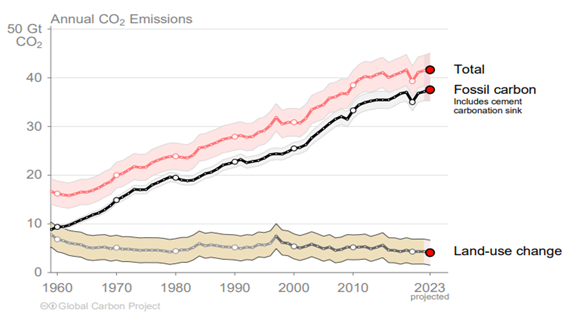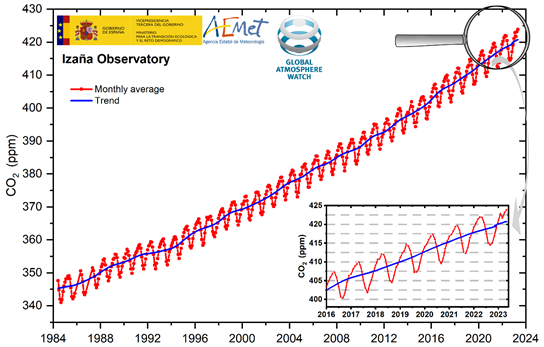Global Carbon Balance 2023
C. Torres1, P.P Rivas1, and S.F. León-Luis2
1Izaña Atmospheric Research Center (IARC), State Meteorological Agency (AEMET), Spain
2TRAGSATEC, Spain
Contact: ctorresg@aemet.es
The Global Carbon Balance 2023, published by the Global Carbon Project, was presented during the Conference of the Parties to the United Nations Framework Convention on Climate Change (COP28), which was held from 30 November to 12 December 2023 in Dubai (United Arab Emirates). Since 2006, this reference report has been updated annually with the collaboration of more than 100 international research institutions and organizations, and aims to provide a global vision of the carbon cycle, analyzing the origin of its emissions, whether natural or anthropogenic and the reabsorption processes in the Earth-atmosphere system [1]. This report is part of the Future Earth research initiative and the World Climate Research Programme (WCRP).
The central conclusion of this report highlights that global carbon dioxide (CO2) emissions from the use of fossil fuels will increase by 1.1% in 2023 compared to the previous year, reaching 36.8 million tonnes of CO2 (GtCO2). This increase is attributed to the more extensive use of all types of fossil fuels, such as coal (+1.1%), oil (+1.5%) and natural gas (+0.5%), and cement production (+0.8%). This places fossil CO2 emissions at a record level, and 1.4% above the pre-COVID-19 pandemic levels recorded in 2019 (see Figure 1). By emitter, the European Union (-7.4%) and the United States (-3.0%) will decrease their emissions, with China (4%), India (8.2%) and the rest of the countries increasing (the latest update of the report does not provide a breakdown of estimated emissions by country, but grouped for the main emitters). Spanish emissions have progressively decreased over the last decade and are currently at the same level as those recorded in 1995. At European level, our emissions represent 8% of the total emitted in 2022[3]. On a positive note, this report highlights that 26 countries, which accounted for 28% of emissions in the period 2013-2022, have reduced their emissions, while in other countries growth is slower. However, these efforts are still insufficient to redress the current situation.
In addition, global CO2 emissions attributable to land use change are estimated at 4.1 GTCO2 by 2023, reflecting a slight decrease over the last two decades. This decrease has been driven mainly by a reduction in permanent deforestation and a slight increase in CO2 sequestration through reforestation. However, the large uncertainty associated with the calculation of forest mass removals prevents confirmation of this decreasing trend (Figure 1).
The Global Carbon Balance 2023, another alarming aspect is highlighted: global CO2 emissions from forest fires exceeded the annual average since the start of satellite observations in 2003. This increase is attributed to an extremely intense fire season in Canada, with emissions estimated at 7-8 GtCO2. This devastating fire season, which began in June, was the focus of international concern due to its enormous negative impact on air quality in North America and Europe. The global atmospheric circulation, with predominantly easterly winds, facilitated the long-range transport of particles and gases generated in these fires, reaching different European countries, including Spain.

Figure1. Annual CO2 Total emissions (red), fossil fuel combustion (black), and land use change (yellow) between 1959 and 2022. The shaded areas represent the uncertainty associated with the measurements (Figure adopted from [2]).
The Izaña Observatory in Tenerife (IZO, Spain, AEMet) measured several episodes where surface CO2 and CO concentrations increased significantly compared to background conditions due to the arrival of air masses from Canada [4]. In contrast, fires in the tropical region, which account for three-quarters of global emissions in the period 2013-2022, were around average in 2023.
The natural sinks of atmospheric CO2, oceanic and terrestrial ecosystems, continue to absorb about half of the emissions, despite the adverse impact of climate change on these ecosystems. According to data available in the Global Carbon Balance 2023, the oceans absorbed a total of 10.4 GtCO2 per year, during the decade 2013-2022 (26% of the total CO2 emitted) and 1.5 GtCO2 more than during the previous decade (2003-2012). Between 2019 and 2022, this sink did not increase its absorption capacity due to the La Niña climate event during 2020-2022, although it is projected to increase its response to emerging El Niño conditions in 2023. Moreover, CO2 uptake by vegetation was 12.3 GtCO2 per year during the decade 2013-2022 (31% of total CO2 emissions), and 0.9 GtCO2 more than during the previous decade (2003-2012). By 2023, this sink is estimated to capture around 10.4 GtCO2, slightly lower than in previous years, in line with expectations from emerging El Niño conditions [1].

Figure 2. Evolution of the CO2 atmospheric concentration from 1850 to the present day, and the contribution of sources and sinks to the increase in the global average concentration of this gas (Figure adopted from [2]).
The imbalance between emissions and sequestration (Figure 2) leads to an increased presence of CO2 in the atmosphere. According to the Global Carbon Balance 2023, the global average concentration of 419.3 parts per million (ppm) [1]. However, observations from background stations of the World Meteorological Organization's Global Monitoring Programme, such as the Izana Observatory (Figure 3) or the Mauna Loa Observatory in Hawaii (MLO, USA, NOAA), show that annual average concentrations, considering the seasonal cycle of atmospheric CO2, have reached 424 ppm during the spring of 2022 [5-7]. Current records are 151% higher than the pre-industrial reference levels of 280 ppm (in 1850) and, with an average annual growth rate of 2.4 ppm over the last decade (2013-2022).
The data in this report confirms that there are no signs that emissions of CO2, the main greenhouse gas, are decreasing. In 2023, total CO2 emissions to the atmosphere will reach a new record of 40.9 GtCO2. This is slightly higher than in 2021 with 40.2 GtCO2 and similar to 2019 emissions. However, it should be noted that the growth of total emissions, the sum of fossil emissions and emissions from land use change, has slowed down over the last decade.

Figure 3. Monthly mean (red dots) and trend (blue line) of CO2 concentration at IZO. The enlargement shows the concentrations in the period 2016-2023.
The Paris Agreement established emission limits to mitigate the global temperature increase to 2ºC and even reduce it to 1.5ºC in this century. According to the Global Carbon Balance 2023, the volume of CO2 that could still be emitted without breaching the climate targets of this agreement has been reduced to 1150 and 275 GtCO2, respectively. At the current rate of emissions, these reference thresholds could be exceeded in only 28 and 7 years.
The European Union has set environmental protection as one of its priorities to mitigate the risks of climate change, making Europe the first carbon-neutral continent by 2050 [7,8]. The European Commission and member countries have promoted the creation of the European research infrastructure Integrated Carbon Observatory System (ICOS), which aims to increase knowledge of the carbon cycle by integrating observations of greenhouse gases from terrestrial, oceanic and atmospheric ecosystems. Spain joined this European network in 2021, and the national node, ICOS-Spain, currently has three atmospheric stations, Izaña, El Arenosillo and CIBA, two oceanic stations, CanOA-SOOP and ESTOC, and an associated ecosystem station, Majadas de Tiétar [9].
References:
[1] Friedlingstein, P., O'Sullivan, M., Jones, M. W., Andrew, R. M., Bakker, D. C. E., Hauck, J., Landschützer, P., Le Quéré, C., Luijkx, I. T., Peters, G. P., Peters, W., Pongratz, J., Schwingshackl, C., Sitch, S., Canadell, J. G., Ciais, P., Jackson, R. B., Alin, S. R., Anthoni, P., Barbero, L., Bates, N. R., Becker, M., Bellouin, N., Decharme, B., Bopp, L., Brasika, I. B. M., Cadule, P., Chamberlain, M. A., Chandra, N., Chau, T.-T.-T., Chevallier, F., Chini, L. P., Cronin, M., Dou, X., Enyo, K., Evans, W., Falk, S., Feely, R. A., Feng, L., Ford, D. J., Gasser, T., Ghattas, J., Gkritzalis, T., Grassi, G., Gregor, L., Gruber, N., Gürses, Ö., Harris, I., Hefner, M., Heinke, J., Houghton, R. A., Hurtt, G. C., Iida, Y., Ilyina, T., Jacobson, A. R., Jain, A., Jarníková, T., Jersild, A., Jiang, F., Jin, Z., Joos, F., Kato, E., Keeling, R. F., Kennedy, D., Klein Goldewijk, K., Knauer, J., Korsbakken, J. I., Körtzinger, A., Lan, X., Lefèvre, N., Li, H., Liu, J., Liu, Z., Ma, L., Marland, G., Mayot, N., McGuire, P. C., McKinley, G. A., Meyer, G., Morgan, E. J., Munro, D. R., Nakaoka, S.-I., Niwa, Y., O'Brien, K. M., Olsen, A., Omar, A. M., Ono, T., Paulsen, M., Pierrot, D., Pocock, K., Poulter, B., Powis, C. M., Rehder, G., Resplandy, L., Robertson, E., Rödenbeck, C., Rosan, T. M., Schwinger, J., Séférian, R., Smallman, T. L., Smith, S. M., Sospedra-Alfonso, R., Sun, Q., Sutton, A. J., Sweeney, C., Takao, S., Tans, P. P., Tian, H., Tilbrook, B., Tsujino, H., Tubiello, F., van der Werf, G. R., van Ooijen, E., Wanninkhof, R., Watanabe, M., Wimart-Rousseau, C., Yang, D., Yang, X., Yuan, W., Yue, X., Zaehle, S., Zeng, J., and Zheng, B.: Global Carbon Budget 2023, Earth Syst. Sci. Data, 15, 5301–5369, https://doi.org/10.5194/essd-15-5301-2023, 2023.
[2] https://globalcarbonbudget.org/download/970/?tmstv=1701687858
[4] https://icos-spain.aemet.es/node/50
[5] https://icos-spain.aemet.es/node/43
[6] https://gml.noaa.gov/ccgg/trends/data.html
[7] IPCC, 2021: Climate Change 2021: The Physical Science Basis. Contribution of Working Group I to the Sixth Assessment Report of the Intergovernmental Panel on Climate Change[Masson-Delmotte, V., P. Zhai, A. Pirani, S.L. Connors, C. Péan, S. Berger, N. Caud, Y. Chen, L. Goldfarb, M.I. Gomis, M. Huang, K. Leitzell, E. Lonnoy, J.B.R. Matthews, T.K. Maycock, T. Waterfield, O. Yelekçi, R. Yu, and B. Zhou (eds.)]. Cambridge University Press, Cambridge, United Kingdom and New York, NY, USA, In press, doi:10.1017/9781009157896.
[8] https://ec.europa.eu/info/strategy/priorities-2019-2024/european-green-deal_es
[9] Cuevas, E., García, O.E., León-Luis, S.F., González-Dávila, M., Adame, J.A., Carrara, A., Vélez-Belchí, P., Delory, E., Rivas-Soriano, P.P., Villalba-Méndez, G., Barreto, A., Curcoll, R., Yela, M. and González-González, A. ICOS-SPAIN Activity Report 2021-2022. (Eds. García, O.E., León-Luis, S.F and González-Dávila, M), State Meteorological Agency (AEMET), Madrid, Spain, NIPO: 666-23-010-3, https://doi.org/10.31978/666-23-010-3, 2023
